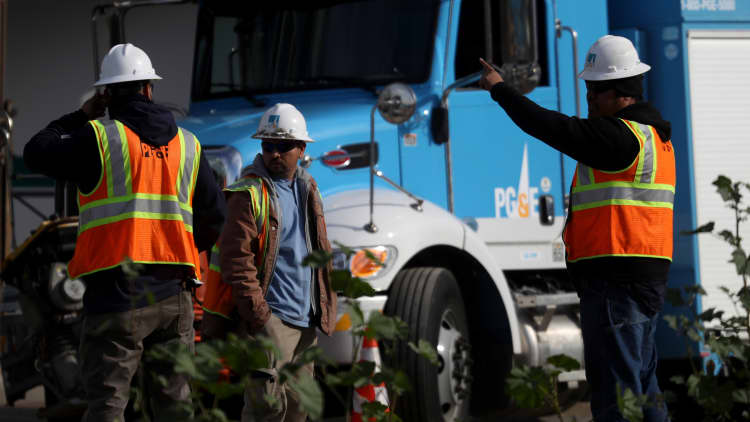
Another season of big wildfire risks in California was never an if, always a when. And so here we are again. Whatever you think of PG&E's management before last year's fires and its fire mitigation plans since it entered into bankruptcy proceedings, many experts assumed at some point PG&E would need to shut down portions of the grid to remove the risk of power lines being taken down by high winds and sparking a wildfire like the one that devastated towns like Paradise in 2018.
So now that, too, is happening. But being angry or feeling helpless against a giant utility won't help anything. PG&E has gotten plenty wrong in the past and may get wrong the decision to shut down power when and where it turns out not to be needed, but the message to Californians — and everyone living in areas at risk of natural disasters — is that it's time to take control of as much power generation as you can.
The fires will keep coming. That's the opinion of wildfire experts from Leroy Westerling, who studies wildfires and climate at the University of California, Merced, to Sarah Lewis McDonald, principal at Envision Geo, a geospatial technology firm that has worked on studies of wildfire risk in California. When she looked back at one forecast map she helped to create before last year's devastating wildfires, what the technology had provided as its best guess turned out to be reality.
"We looked back and said, 'Oh my God.' Here it was, bright on our map.' Bright pink. Paradise. And the other ones that are bright pink on our map remain vulnerable in the future," Lewis McDonald said in an interview with CNBC earlier this year.
The zones of high risk that she called "disproportionately dire" across northern California are not going away, and people who assume that these events are once-in-a-lifetime weather scenarios are making a big gamble.
"These events are going to be more prevalent in future across the West," Lewis McDonald said. She said the previous wildfire season in northern California was "a perfect storm of events of extremes, but with climate change that is going to be case."

Larry Dale, an energy economist with Lawrence Berkeley National Laboratory who worked on studies with Lewis McDonald, said he has "a little sympathy for PG&E."
"They don't have control over where people go or managing the forest, and the weather is changing and they are required to serve everyone."
But he said the issue of drier weather creating more fuel for fires, and high wind events that can cause power lines to come down "seems to be happening a lot more frequently now."
These kinds of wildfires have always occurred, with two new significant changes: wildfires moving into areas that are densely populated and had not previously been seen as high risk and with northern California real estate among the world's most expensive, more people are being pushed farther and farther into communities on what is called the wild-urban interface (known as the WUI by experts).
"In fire research it is a big buzzword," said Lewis McDonald. "Also known as the urban fringe, human population and settlements abutting forest. Humans are moving into the history of fire."
Fire models have been constructed based on the constraints of fire history, or as one expert who builds these models put it, "I can't let the fire burn more crazily than anything we've ever seen," but that level of burn has now become reality. "I can't construct the model to be larger than the largest observed fire ever, but by the time we're finished building a model, the biggest observable fire has doubled in size."
Life in high-risk fire zones
One option that is not an option: forcing people to move.
The socioeconomics of wildfire are already at issue with more communities forced to the fringe of one of the nation's most expensive states. While PG&E is employing new wildfire prevention methods, including the laying of underground power lines, there is no perfect solution and there is realistically no mass migration option, either.
"You're not going to tell a population to leave or bear the full cost of living there," said one utility expert in California who spoke with me earlier this year about the situation as PG&E entered bankruptcy. The expert could not be named, as he was being called to testify as an expert in the bankruptcy proceedings.
"We have 2 million homes in high- and severe-risk wildfire areas, according to insurance industry estimates. You can't tell 2 million people to leave and while some are very rich, lots of them are low-income, like in Paradise," the expert said.
Lewis McDonald said when she was in the market for a home, she was thinking about locations in terms of putting her family in a vulnerable situation. She said homeowners living in areas at risk of wildfires now need to think about "defensible space," because when you look at the structures that burned versus the structures that remained, having landscaped properly to remove fuel for the fire and using building materials that are fire-resistant made a big difference. In fact, she said if firefighters see a home that does not appear to be defensible these days, "they won't even try; they move onto the next house."
And that goes for the utility, too. "You can't just ask PG&E to do it for you," she said.
So what can you do? One thing people are doing is lining up at gas stations to get every last drop of fossil fuel to power their emergency generators. That works, but will become a perverse option in a world in which increasing natural disasters caused by climate change, which is caused by burning carbon, are occurring.
The economics of diesel are not great either, according to Jigar Shah of Generate Capital, a firm that provides capital to businesses focused on sustainability, but he said the current supply-demand balance favors them.
"It is clear from Generac's stock price that many people are buying diesel engines as back up power right now. Depending on the usage of these diesel engines, these units will cost almost $1/kilowatt hour compared to average commercial rates of $0.14/kWh. It would be far more effective to meet the resiliency needs of customers with local microgrids like the ones put forward by Schneider Electric," Shah said.
Shah said the State of California has suggested that customers pursue a path that would be consistent with their goals of 100% clean electricity, but the reality is that diesel generators are in inventory and clean energy solutions take six to nine months of planning to install correctly and cost-effectively.
California is the bleeding edge of how communities defend themselves from natural disasters and climate risks. Many methods of response are being tested in communities, from heat sensors being installed in open spaces between likely ignition spots to the construction of huge water tanks at key building locations.
When I look at the root cause of fires sparked by transmission lines, I don't see solutions out there other than distributed generation.Adam Browningexecutive director of Vote Solar
PG&E has said during the bankruptcy process that it understands it must play a leading role in implementing change that will help mitigate the risk of wildfires. It also has noted that the threat of wildfire is a complex one, and will require comprehensive solutions from a wide range of stakeholders to fully address.
Taking more control over power generation, and forcing legislators and regulators to offer more control over power generation through renewable energy sources like solar, battery storage and microgrids controlled within a community, should be priorities for Californians in the dark this week.
A "Manhattan Project" for grid resiliency may or may not be an accomplishment that states like California and companies like PG&E can one day look back on as a success, but we are not there yet, and PG&E's track record does not breed confidence. What's more, the utility industry approach to renewable energy — fostered by state laws — has been to meet their carbon-neutral goals by building massive solar and wind projects that feed into their existing transmission lines. That may help California reach its renewable energy production targets, but when the power is shut off, it is not delivering on power to the utility ratepayers.
Utilities typically view the concept of distributed generation — power being sourced directly from individual, small-scale projects rather than generated by power plants they own or merchant generators from which they buy — as an existential threat. When the existential threat is your family, home and community, it's time to push back against utility industry efforts to limited distributed generation like solar panels on your home. And at some point the rate increases utilities will try to push through to pay for grid resiliency may reach the breaking point where investing in your own power would be more cost-effective.
That threshold is not necessarily near, and the biggest leap needs to be in how low-income energy would be delivered, experts noted. Today, affluent homeowners in areas where power was shut off have their home solar systems and battery storage to rely on.
As one expert put it: "If you are on the tracks and the train is coming, you need to get off the tracks. Don't just say the train is coming at me."
Defending in place
"When I look at the root cause of fires sparked by transmission lines, I don't see solutions out there other than distributed generation," said Adam Browning, executive director at San Francisco-based Vote Solar. "DG resiliency will be critical for services to be provided if you de-energize transmission lines."
"Relying on customers to modulate and own their own supply, that is directly at odds the with regulatory model that supports capital deployment by utilities," Browning said, spending funded by the ratepayers. He said if the key question is evaluating what we ask utilities to do, "We need to point them towards the end goals of resiliency, safety and clean generation." And a much more expansive toolset in terms of the solution.
Companies like Tesla and Sunrun which sell solar power and energy storage solutions are pushing distributed generation. Rooftop solar without storage is not enough, and the solar combined with storage market is only beginning to grow and remains expensive for many.
Meanwhile, PG&E's sole proposal for a "resilience zone" microgrid project in the Sonoma County town of Angwin was postponed this past summer because of the need to prevent the microgrid from causing its own fire risks, according to Greentech Media.
Even efforts like that one were "pretty laughable," according to Timothy Hade of Scale Microgrid Solutions. "They primarily relied on diesel generators, which is a terrible technology to deploy given the circumstances."
"I don't think the State has done nearly enough to address distributed energy resources/microgrids. ... The utility wildfire mitigation plans + a lot of the State/CPUC work to date have almost completely ignored DERs," Hade wrote in an email, and he added that was despite all the parties knowing that power shutdown events were going to be essential.
"Ultimately, the State is going to need a mass deployment of DERs. Rooftop solar + storage systems will be the key technology, but many other technologies must play a role. Unfortunately, while some of the best distributed energy companies in the world are based in California, we have been largely excluded from the utility/CPUC wildfire mitigation planning process," he said.
The California Public Utilities Commission has some long-term microgrid projects in the works, and also approved changes to the state's Self-Generation Incentive Program (SGIP) to direct $100 million of its budget toward disadvantaged or medically vulnerable residents of high-fire-risk areas.
But California needs to do more. Browning's group is pushing four steps to break the utility's lock on power when it is on and off.
First, protecting consumers from unfair utility-imposed costs and barriers to solar and storage. Second, updating CPUC rules to allow local clean energy and storage to fully participate in markets for electricity, grid services and resource adequacy, reducing the need for large fossil-fired plants and related transmission lines. Third, fully funding the CPUC's Self Generation Incentive Program at the maximum amount allowable by law to make storage more accessible to more consumers, prioritizing low-income and vulnerable populations and those who need backup power in areas more vulnerable to power shutoffs. Finally, supporting local governments in rapidly installing thousands of solar + storage backup power systems/microgrids on critical facilities
"Defending in place" is now a debate point in California community decisions over wildfire. It is a given that, at some point, the fire will come. Some communities that have only one road in and out, limiting evacuation options, are only being realistic in planning to defend structures like schools "in place" as the fire comes. That's the last line of defense. The ability to invest in renewable energy today and demand that the government, regulators and utilities give citizens the means to do so at all income-levels of community, should come well before the spark of ignition, and before the next time PG&E, or any utility, shuts down the power supply.





